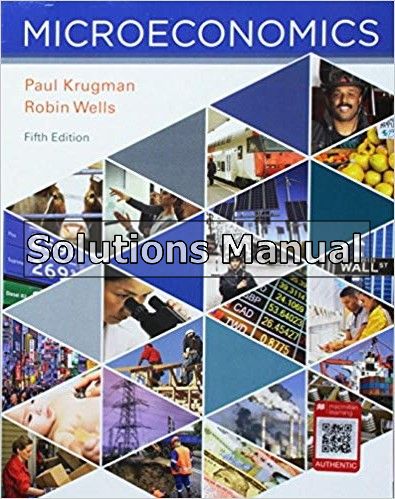This is completed downloadable of Microeconomics 5th Edition Krugman Solutions Manual

Product Details:
- ISBN-10 : 1319098789
- ISBN-13 : 978-1319098780
- Author:
Enhance your comprehension of how economic concepts function today with the unique and impactful storytelling stye and digital resources from Microeconomics.
Table of Content:
- Section 1 Basic Economic Concepts
- A Day in the Megacity
- Module 1 First Principles
- 1.1 The Invisible Hand
- My Benefit, Your Cost
- Good Times, Bad Times
- Onward and Upward
- 1.2 Principles That Underlie Individual Choice: The Core of Economics
- Principle #1: Choices Are Necessary Because Resources Are Scarce
- Principle #2: The True Cost of Something Is Its Opportunity Cost
- Principle #3: “How Much” Is a Decision at the Margin
- Principle #4: People Usually Respond to Incentives, Exploiting Opportunities to Make Themselves Better Off
- 1.3 Interaction: How Economies Work
- Principle #5: There Are Gains from Trade
- Principle #6: Markets Move Toward Equilibrium
- Principle #7: Resources Should Be Used Efficiently to Achieve Society’s Goals
- Principle #8: Markets Usually Lead to Efficiency, But When They Don’t, Government Intervention Can Improve Society’s Welfare
- 1.4 Economy-Wide Interactions
- Principle #9: One Person’s Spending Is Another Person’s Income
- Principle #10: Overall Spending Sometimes Gets Out of Line with the Economy’s Productive Capacity
- Principle #11: Increases in the Economy’s Potential Lead to Economic Growth Over Time
- Module 2 Models and the Production Possibility Frontier
- 2.1 Models Take Flight in Economics
- 2.2 Trade-Offs: The Production Possibility Frontier
- Efficiency
- Opportunity Cost
- Economic Growth
- Economics in Action: Lights, Camera—But Where’s the Action Figure?
- Module 3 Comparative Advantage and Trade
- 3.1 Comparative Advantage and Gains from Trade
- Comparative Advantage and International Trade, in Reality
- Economics in Action: Rich Nation, Poor Nation
- Module 4 The Circular-Flow Diagram
- 4.1 The Circular-Flow Diagram
- 4.2 Positive versus Normative Economics
- Business Case: Efficiency, Opportunity Cost, and the Logic of Lean Production
- Section 1 Review
- Section 1 Summary
- Section 1 Key Terms
- Appendix 1 Graphs in Economics
- Getting the Picture
- Graphs, Variables, and Economic Models
- How Graphs Work
- Two-Variable Graphs
- Curves on a Graph
- A Key Concept: The Slope of a Curve
- The Slope of a Linear Curve
- Horizontal and Vertical Curves and Their Slopes
- The Slope of a Nonlinear Curve
- Calculating the Slope Along a Nonlinear Curve
- Maximum and Minimum Points
- Calculating the Area Below or Above a Curve
- Graphs That Depict Numerical Information
- Types of Numerical Graphs
- Section 2 Demand, Supply, and Equilibrium
- A Natural Gas Boom
- Module 5 Demand
- 5.1 Supply and Demand: A Model of a Competitive Market
- 5.2 The Demand Curve
- The Demand Schedule and the Demand Curve
- Shifts of the Demand Curve
- Understanding Shifts of the Demand Curve
- Economics in Action: Beating the Traffic
- Module 6 Supply and Equilibrium
- 6.1 The Supply Curve
- The Supply Schedule and the Supply Curve
- Shifts of the Supply Curve
- Understanding Shifts of the Supply Curve
- 6.2 Supply, Demand, and Equilibrium
- Finding the Equilibrium Price and Quantity
- 1. Why Do All Sales and Purchases in a Market Take Place at the Same Price?
- 2. Why Does the Market Price Fall If It Is Above the Equilibrium Price?
- 3. Why Does the Market Price Rise If It Is Below the Equilibrium Price?
- Using Equilibrium to Describe Markets
- Economics in Action: The Price of Admission
- Module 7 Changes in Equilibrium
- 7.1 Changes in Supply and Demand
- What Happens When the Demand Curve Shifts
- What Happens When the Supply Curve Shifts
- Simultaneous Shifts of Supply and Demand Curves
- 7.2 Competitive Markets—And Others
- Economics in Action: Where’s the Guacamole?
- Business Case: Uber Gives Riders a Lesson in Supply and Demand
- Section 2 Review
- Section 2 Summary
- Section 2 Key Terms
- Section 3 Market Efficiency and Price Controls
- Making Gains by the Book
- Module 8 Consumer and Producer Surplus
- 8.1 Consumer Surplus and the Demand Curve
- Willingness to Pay and the Demand Curve
- Willingness to Pay and Consumer Surplus
- How Changing Prices Affect Consumer Surplus
- 8.2 Producer Surplus and the Supply Curve
- Cost and Producer Surplus
- How Changing Prices Affect Producer Surplus
- Economics in Action: A Matter of Life and Death
- Module 9 Efficiency and Markets
- 9.1 Consumer Surplus, Producer Surplus, and the Gains from Trade
- The Gains from Trade
- The Efficiency of Markets
- Equity and Efficiency
- 9.2 A Market Economy
- Why Markets Typically Work So Well
- A Few Words of Caution
- Economics in Action: A Great Leap—Backward
- Module 10 Price Controls (Ceilings and Floors)
- 10.1 Why Governments Control Prices
- 10.2 Price Ceilings
- Modeling a Price Ceiling
- How a Price Ceiling Causes Inefficiency
- So Why Are There Price Ceilings?
- 10.3 Price Floors
- How a Price Floor Causes Inefficiency
- So Why Are There Price Floors?
- Economics in Action: The Rise and Fall of the Unpaid Intern
- Business Case: Ticket Prices and Music’s Reigning Couple, Jay-Z and Beyoncé
- Section 3 Review
- Section 3 Summary
- Section 3 Key Terms
- Section 4 Elasticity and Law of Demand
- Taken for a Ride
- Module 11 Defining and Measuring Elasticity
- 11.1 Calculating the Price Elasticity of Demand
- An Alternative Way to Calculate Elasticities: The Midpoint Method
- Economics in Action: Estimating Elasticities
- Module 12 Interpreting the Price Elasticity of Demand
- 12.1 How Elastic Is Elastic?
- 12.2 Price Elasticity Along the Demand Curve
- 12.3 What Factors Determine the Price Elasticity of Demand?
- Whether the Good Is a Necessity or a Luxury
- The Availability of Close Substitutes
- Share of Income Spent on the Good
- Time Elapsed Since Price Change
- Economics in Action: Responding to Your Tuition Bill
- Module 13 Other Elasticities
- 13.1 The Cross-Price Elasticity of Demand
- 13.2 The Income Elasticity of Demand
- 13.3 The Price Elasticity of Supply
- Measuring the Price Elasticity of Supply
- What Factors Determine the Price Elasticity of Supply?
- An Elasticity Menagerie
- Economics in Action: China and the Global Commodities Glut of 2016
- Module 14 The Benefits and Costs of Taxation
- 14.1 The Economics of Taxes: A Preliminary View
- The Effect of an Excise Tax on Quantities and Prices
- Price Elasticities and Tax Incidence
- 14.2 The Benefits and Costs of Taxation
- The Revenue from an Excise Tax
- Tax Rates and Revenue
- 14.3 The Costs of Taxation
- 14.4 Elasticities and the Deadweight Loss of a Tax
- Economics in Action: Taxing Tobacco
- Business Case: The Airline Industry: Fly Less, Charge More
- Section 4 Review
- Section 4 Summary
- Section 4 Key Terms
- Section 5 International Trade
- The Everywhere Phone
- Module 15 Gains from Trade
- 15.1 Comparative Advantage and International Trade
- Production Possibilities and Comparative Advantage, Revisited
- The Gains from International Trade
- Comparative Advantage versus Absolute Advantage
- Popular Misconceptions Arising from Misunderstanding Comparative Advantage
- Sources of Comparative Advantage
- Economics in Action: How Hong Kong Lost Its Shirts
- Module 16 Supply, Demand, and International Trade
- 16.1 Imports, Exports, and Wages
- The Effects of Imports
- The Effects of Exports
- International Trade and Wages
- 16.2 The Effects of Trade Protection
- The Effects of a Tariff
- The Effects of an Import Quota
- 16.3 The Political Economy of Trade Protection
- Arguments for Trade Protection
- The Politics of Trade Protection
- International Trade Agreements and the World Trade Organization
- 16.4 Challenges to Globalization
- Greater Inequality Arising from Trade
- Outsourcing
- Economics in Action: Trade War, What Is It Good For?
- Business Case: Li & Fung: From Guangzhou to You
- Section 5 Review
- Section 5 Summary
- Section 5 Key Terms
- Section 6 Economics and Decision Making
- The Payback Game Shows Students How to Make Good Decisions
- Module 17 Making Decisions
- 17.1 Costs, Benefits, and Profits
- Explicit versus Implicit Costs
- Accounting Profit versus Economic Profit
- Making “Either–Or” Decisions
- 17.2 Making “How Much” Decisions: The Role of Marginal Analysis
- Marginal Cost
- Marginal Benefit
- Marginal Analysis
- 17.3 Sunk Costs
- Economics in Action: The Cost of a Life
- Module 18 Behavioral Economics
- 18.1 How People Make Economic Choices
- Rational, but Human, Too
- Irrationality: An Economist’s View
- Rational Models for Irrational People?
- Economics in Action: In Praise of Hard Deadlines
- Module 19 Maximizing Utility
- 19.1 Utility: Getting Satisfaction
- Utility and Consumption
- The Principle of Diminishing Marginal Utility
- 19.2 Budgets and Optimal Consumption
- Budget Constraints and Budget Lines
- Optimal Consumption Choice
- 19.3 Spending the Marginal Dollar
- Marginal Utility per Dollar
- Optimal Consumption
- 19.4 From Utility to the Demand Curve
- Marginal Utility, the Substitution Effect, and the Law of Demand
- The Income Effect
- Economics in Action: Lower Gasoline Prices and the Urge to Splurge
- Business Case: Beyond Impossible: McDonald’s and Burger King’s Beef-Free Battle
- Section 6 Review
- Section 6 Summary
- Section 6 Key Terms
- Section 7 Production and Costs
- The Farmer’s Margin
- Module 20 The Production Function
- 20.1 The Production Function
- Inputs and Output
- Economics in Action: Finding the Optimal Team Size
- Module 21 Firm Costs
- 21.1 From the Production Function to Cost Curves
- 21.2 Two Key Concepts: Marginal Cost and Average Cost
- Marginal Cost
- Average Total Cost
- Minimum Average Total Cost
- Does the Marginal Cost Curve Always Slope Upward?
- Economics in Action: Smart Grid Economics
- Module 22 Long-Run Costs and Economies of Scale
- 22.1 Short-Run versus Long-Run Costs
- Returns to Scale
- Summing Up Costs: The Short and Long of It
- Economics in Action: How the Sharing Economy Reduces Fixed Cost
- Business Case: The Rise of the Machine at Amazon
- Section 7 Review
- Section 7 Summary
- Section 7 Key Terms
- Section 8 Market Structure and Perfect Competition
- Deck the Halls
- Module 23 Introduction to Market Structure
- 23.1 Types of Market Structure
- 23.2 Perfect Competition
- Defining Perfect Competition
- Conditions That Lead to Perfect Competition
- 23.3 Monopoly
- Defining Monopoly
- Why Do Monopolies Exist?
- 23.4 Oligopoly
- Defining Oligopoly
- Oligopoly and the Potential for Collusion
- Is It an Oligopoly or Not?
- 23.5 Monopolistic Competition
- Defining Monopolistic Competition
- Economics in Action: The Monopoly That Wasn’t: China and the Market for Rare Earths
- Module 24 Perfect Competition
- 24.1 Production and Profits
- The Optimal Output Rule
- The Optimal Output Rule for a Price-Taking Firm
- Produce or Shut Down?
- Module 25 Graphing Perfect Competition
- 25.1 Graphing Perfect Competition
- The Short-Run Production Decision
- The Long Run: Changing Fixed Cost, Entry and Exit
- Summing Up: The Perfectly Competitive Firm’s Profitability and Production Conditions
- Economics in Action: Farmers Know How
- Module 26 Long-Run Outcomes in Perfect Competition
- 26.1 The Perfectly Competitive Industry Supply Curve
- The Short-Run Industry Supply Curve
- The Long-Run Market Equilibrium
- The Cost of Production and Efficiency in Long-Run Equilibrium
- Economics in Action: A Global Pork Shortage Hits Chinese Diners Hard
- Business Case: Retail Wars: Big Box Stores in the Age of Amazon
- Section 8 Review
- Section 8 Summary
- Section 8 Key Terms
- Section 9 Monopoly
- “Shine Bright Like a Diamond”
- Module 27 Monopoly in Practice
- 27.1 The Monopolist’s Demand Curve and Marginal Revenue
- Comparing Demand Curves
- Comparing Marginal Revenue and Price
- Why Marginal Revenue Differs from Price for a Monopolist
- 27.2 The Monopolist’s Profit-Maximizing Output and Price
- 27.3 Monopoly versus Perfect Competition
- 27.4 Monopoly: The General Picture
- Economics in Action: Shocked by the High Price of Electricity
- Module 28 Monopoly, Government Policy, and Social Welfare
- 28.1 Welfare Effects of Monopoly
- 28.2 Government Policy Toward Monopoly
- 28.3 Dealing with Natural Monopoly
- 1. Public Ownership
- 2. Regulation
- 28.4 Network Externalities and Dominant Firms: A New Generation of Market Power
- Economics in Action: A New Generation of Market Power
- Module 29 Price Discrimination
- 29.1 Price Discrimination Defined
- 29.2 The Logic of Price Discrimination
- 29.3 Price Discrimination and Elasticity
- 29.4 Perfect Price Discrimination
- Business Case: Amazon and Hachette Go to War
- Section 9 Review
- Section 9 Summary
- Section 9 Key Terms
- Section 10 Oligopoly and Monopolistic Competition
- Regulators Give Bridgestone a Flat Tire
- Module 30 Oligopoly
- 30.1 Understanding Oligopoly
- A Duopoly Example
- Collusion and Competition
- 30.2 Oligopoly in Practice
- The Legal Framework
- Tacit Collusion and Price Wars
- Economics in Action: The Case Against Chocolate Producers Melts
- Module 31 Game Theory
- 31.1 Games Oligopolists Play
- The Prisoners’ Dilemma
- Overcoming the Prisoners’ Dilemma: Repeated Interaction and Tacit Collusion
- Economics in Action: The Demise of OPEC
- Module 32 Monopolistic Competition
- 32.1 Understanding Monopolistic Competition
- Monopolistic Competition in the Short Run
- Monopolistic Competition in the Long Run
- 32.2 Monopolistic Competition versus Perfect Competition
- Price, Marginal Cost, and Average Total Cost
- Is Monopolistic Competition Inefficient?
- Economics in Action: Hits and Flops in the App Store
- Module 33 Product Differentiation and Advertising
- 33.1 How Firms Differentiate Their Products
- Differentiation by Style or Type
- Differentiation by Location
- Differentiation by Quality
- Product Differentiation: In Sum
- 33.2 Controversies About Product Differentiation
- The Role of Advertising
- Brand Names
- Economics in Action: The Perfume Industry: Leading Consumers by the Nose
- Business Case: Virgin Atlantic Blows the Whistle . . . or Blows It?
- Section 10 Review
- Section 10 Summary
- Section 10 Key Terms
- Section 11 Market Failure and the Role of Government
- Trouble Underfoot
- Module 34 Externalities
- 34.1 The Economics of a Negative Externality: Pollution
- The Costs and Benefits of Pollution
- Why a Market Economy Produces Too Much Pollution
- The Inefficiency of Excess Pollution
- 34.2 The Economics of Positive Externalities
- Preserved Farmland: A Positive Externality
- Positive Externalities in Today’s Economy
- Economics in Action: Texting and Driving
- Module 35 Pollution, Government Policy, and the Great Energy Transition
- 35.1 Government Policies to Address Pollution
- Environmental Standards
- Emissions Taxes versus Environmental Standards
- Tradable Emissions Permits
- 35.2 The Economics of Climate Change and the Great Energy Transition
- The Cause of Climate Change
- Policies to Address Climate Change
- Climate Change Mitigation: Costs and Benefits
- Economics in Action: Over 3,500 Economists Agree: Tax Greenhouse Gas Emissions
- Module 36 Public Goods and Common Resources
- 36.1 Private Goods—And Others
- Characteristics of Goods
- Why Markets Can Supply Only Private Goods Efficiently
- 36.2 Public Goods
- Providing Public Goods
- How Much of a Public Good Should Be Provided?
- 36.3 Common Resources
- The Problem of Overuse
- The Efficient Use and Maintenance of a Common Resource
- 36.4 Artificially Scarce Goods
- Economics in Action: Twenty-First-Century Piracy
- Business Case: Xcel Energy Goes for a Win-Win
- Section 11 Review
- Section 11 Summary
- Section 11 Key Terms
- Section 12 Factor Markets and the Distribution of Income
- The Value of a Degree
- Module 37 Factor Markets
- 37.1 The Economy’s Factors of Production
- Why Factor Prices Matter
- Factor Incomes and the Distribution of Income
- 37.2 Marginal Productivity and Factor Demand
- Value of the Marginal Product
- Value of the Marginal Product and Factor Demand
- Shifts of the Factor Demand Curve
- Economics in Action: The Factor Distribution of Income in the United States
- Module 38 Marginal Productivity Theory and the Economy’s Distribution of Income
- 38.1 The Marginal Productivity Theory of Income Distribution
- 38.2 Is the Marginal Productivity Theory of Income Distribution Really True?
- Wage Disparities in Practice
- Wage Disparities Explained By the Marginal Productivity Theory
- 38.3 Wage Disparities Unexplained by Marginal Productivity Theory
- Market Power
- Efficiency Wages
- Discrimination
- Economics in Action: Marginal Productivity and the Minimum-Wage Puzzle
- Module 39 The Market for Labor
- 39.1 The Supply of Labor
- Work versus Leisure
- Wages and Labor Supply
- Shifts of the Labor Supply Curve
- Economics in Action: The Real Housewives of the United States
- Module 40 The Economics of the Welfare State
- 40.1 Poverty, Inequality, and Public Policy
- The Logic of the Welfare State
- The Problem of Poverty
- Economic Inequality
- Economic Insecurity
- 40.2 The U.S. Welfare State
- Social Security and Unemployment Insurance
- The Effects of the Welfare State on Poverty and Inequality
- 40.3 Health Care and the Welfare State
- The Economics of Health Insurance
- Government Health Insurance
- The Affordable Care Act
- Effects of the ACA
- Economics in Action: Long-Term Trends in Income Inequality in the United States
- Business Case: Walmart Revolutionizes Its Labor Practices
- Section 12 Review
- Section 12 Summary
- Section 12 Key Terms
- Solutions to Check Your Understanding Questions
- Glossary
- Index
- Back Cover





